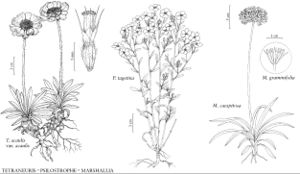Psilostrophe
in A. P. de Candolle and A. L. P. de Candolle, Prodr. 7: 261. 1838.
| Taxon | Illustrator ⠉ | |
|---|---|---|
 | Tetraneuris acaulis Psilostrophe tagetina Marshallia caespitosa Marshallia graminifolia | Yevonn Wilson-Ramsey Yevonn Wilson-Ramsey Yevonn Wilson-Ramsey Yevonn Wilson-Ramsey |
Biennials, perennials, subshrubs, or shrubs (rarely flowering first-year), 8–60+ cm. Stems erect to spreading, branched from bases or throughout (not scapiform). Leaves basal and cauline or all cauline; alternate; petiolate or sessile; blades spatulate to oblanceolate or linear, margins usually entire (sometimes toothed or lobed on larger rosette leaves), faces densely to sparsely arachno-villous or ± strigillose, often glanddotted as well. Heads radiate, usually in compact, corymbiform arrays or glomerulate clusters (borne singly in P. cooperi). Involucres cylindric to campanulate or obconic, 2–7 mm diam. Phyllaries persistent, 5–12 in 1–2 series (erect in fruit, distinct, oblong to lanceolate, bases ± indurate). Receptacles flat or convex, smooth or ± pitted (without setiform enations, sometimes glanddotted), epaleate. Ray-florets 1–8, pistillate, fertile; corollas yellow to orange (marcescent, spreading or reflexed in fruit). Disc-florets 5–25+, bisexual, fertile; corollas yellow to orange, tubes shorter than narrowly cylindric throats, lobes 5, deltate (equal, papillate abaxially). Cypselae cylindric to clavate or obpyramidal, sometimes weakly obcompressed (ray), all striate-ribbed, usually glabrous, sometimes glanddotted (villous in P. gnaphalodes, sometimes hirtellous in P. tagetina); pappi of 4–8 ± oblong or elliptic to lanceolate or lance-subulate, entire (lacerate in P. gnaphalodes) scales (without prominent midribs). x = 16.
Distribution
United States, Mexico
Discussion
Species 7 (6 in the flora).
My treatment of psilostrophes closely follows that by R. C. Brown (1978). Psilostrophe mexicana R. C. Brown is known from Chihuahua and Durango.
Selected References
Lower Taxa
Key
| 1 | Subshrubs or shrubs; stems pannose (white); heads borne singly; peduncles 35–60(–80+) mm | Psilostrophe cooperi |
| 1 | Biennials or perennials; stems arachno-villous (gray to gray-green) or strigillose (greenish); heads in corymbiform arrays; peduncles 0.5–25(–50) mm | > 2 |
| 2 | Stems ± strigillose, (greenish, sometimes ± villous in proximal axils); ray laminaereflexed in fruit | Psilostrophe sparsiflora |
| 2 | Stems mostly arachno-villous (gray to gray-green); ray laminae spreading in fruit | > 3 |
| 3 | Involucres 7–9(–12) mm; disc florets (10–)12–15(–20); pappus scales oblong to ovate, 1.5–2 mm | Psilostrophe bakeri |
| 3 | Involucres 4–6(–8) mm; disc florets 5–8(–12); pappus scales elliptic or lanceolate to linear-subulate, 2–3+ mm | > 4 |
| 4 | Cypselae villous | Psilostrophe gnaphalodes |
| 4 | Cypselae usually glabrous, sometimes hirtellous and/or gland-dotted | > 5 |
| 5 | Peduncles (3–)12–20(–40) mm; ray laminae (5–)7–14+ mm | Psilostrophe tagetina |
| 5 | Peduncles (0.5–)1–3(–5+) mm; ray laminae 3–4(–6) mm | Psilostrophe villosa |